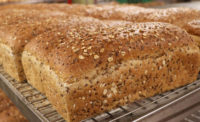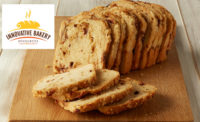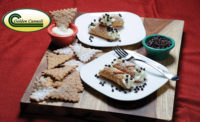Strategies to build appeal into breads, buns and rolls
Bread is a $13 billion business—but sales are flat. What will drive this pantry staple into the future?

courtesy of AB Mauri North America

courtesy of Alvarado Street Bakery

courtesy of Puratos Corp.

courtesy of Ardent Mills

courtesy of Euro-Bake

courtesy of AB Mauri North America

courtesy of AB Mauri North America

courtesy of Cargill








Bread is essential. It’s perhaps the oldest known prepared food. But within simplicity, lies a complex nature that continually unfolds.
Fresh bread remains the largest category in bakery. According to IRI, Chicago, fresh bread and rolls accounted for $13.0 billion in sales for the 52 weeks ending November 27, 2016—but grew by only 0.4 percent in dollar sales. Buns and rolls generally fared better than fresh bread in terms of growth. Top performers for the period, per IRI, included King’s Hawaiian (up 19.0 in hamburger and hot dog buns, and14.5 in fresh buns, rolls and croissants) and Campbell Soup Co. (up 16.9 in hamburger and hot dog buns, and 12.7 in fresh buns, rolls and croissants). H&S Bakery notes that overall company sales were up 12 percent compared to the previous year. But what are the key aspects of this growth?
“Although there are a number of trends across the baking industry today, several stand out, including both consumer and customer demand for more artisan breads, variety in flavor and provenance, and clean-label offerings,” says Marie Thomas, vice president of innovation, bakery ingredients, AB Mauri North America, St. Louis.
Top trends
“Clean label continues to be one of the biggest trends in retail breads today,” says Kathy Sargent, market director, bakery, Corbion, Lenexa, KS. “Developing a solid formulation that offers a cleaner label with good taste, texture and tolerance is critical to ensuring consumer acceptance and, ultimately, market success in retail bread.”
With such a large category as bread, niches can prove profitable. “The trends of super-premium, organic, gluten-free, non-GMO and nutritional supplementation continue, however at a different pace,” says Pat Shannon, business development, Grain Millers, Inc., Eugene, OR. “These trends continue at more-normal growth rates, many still small in market share, but with shelf space allocated as part of the regular lineup. Organic market share continues to climb as bakers increase year-over-year contracts for organic raw material supplies from growers and/or processors giving them the ability to expand varieties.”
Simplicity and nutrition remain a common theme in bread. “We’ve seen an uptick in consumers wanting healthier, simpler foods in their diets,” says Andrew Blok, brand director, La Brea Bakery, Los Angeles. “Trends have shown that consumers are turning a corner. Additionally, with food allergies and gluten intolerances on the rise, consumers have wanted more transparency around the ingredients used in store-bought breads. They want to know where their bread actually comes from, and how it’s made. We have transitioned our entire line of artisan breads to be Non-GMO Project Verified as of December 31, 2016.”
Much of this momentum falls under the umbrella of better-for-you. “Better-for-you is certainly seeing success,” says Michael Girkout, director of marketing, Alvarado Street Bakery, Petaluma, CA. “Whole grains and seeds are appearing as inclusions, as well as ‘enrobing’ bread loaves—not just topped with seeds, but covered in seed blends on all sides. USDA certified organic continues to appear on packages, both in-store bakery as well as commercial bread sets. Also trending is the non-GMO statement.” While certified organic equates to non-GMO, not all consumers are aware of this fact, he notes.
“The biggest movement we’re seeing in the retail bread industry is the constant quest to make products as clean label as possible,” says Catherine Barry, director of marketing, National Honey Board, Firestone, CO. “This includes reformulating existing loaves to remove artificial ingredients and launching new products with ingredient labels that don’t require a chemistry degree to read. Honey’s sweet flavor allows bread manufacturers to sweeten breads, mask off-flavors of some whole grains, all while providing countless functional benefits, such as mouthfeel, color and natural shelf-life extension.”
Vanessa Espejo, Bakery Product Manager, Puratos Corp., Cherry Hill, NJ cites organic, non-GMO, whole-meal and whole-grain driving bread trends. She also says sprouted grains will continue to grow in the in-store bakery (ISB) and packaged bread aisle.
“One trend that we’ve enjoyed watching is the visual transformation of gluten-free breads,” says Chris Krenzel, director of sales, Firebird Artisan Mills Harvey, ND. “In the past, nobody wanted to showcase gluten-free breads, because they haven’t been all that attractive. Now bakers are much more comfortable with gluten-free formulations, and they’re creating breads that are not only delicious, they’re visual masterpieces. The days of the flat, tasteless loaves are long gone.”
Foodservice momentum
Walt Postelwait, president, Pak Group, Pasadena, CA, notes that artisanal, high-quality buns and rolls like pretzel and brioche are driving interest in foodservice. “Consumers are looking for higher-quality options when it comes to buns and rolls.”
A major trend is the upscaling of the sandwich—particularly the quality of the sandwich carrier itself, notes Rosenberg. “Depending on what research you read, consumers say that the bread is either the No. 1 or No. 2 most-important part in making a great sandwich. We’ve seen tremendous growth in Euro-Bake gourmet burger buns, such as brioche and pretzel varieties, as well as in more artisan-style sandwich carriers such as our Basil Cheese Focaccia.” He notes that another trend in foodservice is the rise in ethnic sandwiches like bánh mì, torta Cuban, etc., and each requires different bread options.
“Flavored and healthier buns are definitely a trend,” says Espejo. A stronger grain focus is also in the cards. “Wendy’s launched a multigrain bun, which is a big step for this foodservice channel. We will wait to see if other QSRs will follow. Also, chains like Starbucks are increasingly adding more and more sandwich options to their menu, ranging from ciabattas to flatbreads, which shows an opportunity for bakers to bring innovation.”
The right level of diversity can build interest. “A lot of burger establishments feel stuck on brioche or the basic hamburger/sandwich bun,” says Daniel Marciani, executive development chef, RQT, Ardent Mills, Denver. “Why not a make a brioche potato roll or a pretzel hamburger bun? What about something completely out of the box, like a sriracha and quinoa torta bun, or a heritage wheat sourdough pretzel roll?”
Sandwich chains could offer a turkey and cranberry sauce sandwich on a sweet potato-based bread as an LTO menu item with seasonal and artisanal appeal, suggests John Kimber, COO, Carolina Innovative Food Ingredients, Nashville, NC.
“Gourmet appears to be driving the market, even from fast-food chains that have traditionally competed solely on price,” says Barry. “We’re seeing bigger buns and rolls and more varieties. Ciabatta is being used with hamburgers, and everyone is trying to get more whole grains in their products.”
And when diversity brings nutrition into the loop, it’s a win-win. “As consumers are becoming more particular about what is in their food and where it comes from, they are looking for healthier alternatives to ‘regular’ white bread,” says Jay Johnson, senior vice president of sales, Healthy Food Ingredients, Fargo, ND. “Better-for-you ingredients and trends are increasing in demand and include gluten-free, clean label/less processed, specialty grains and organic.”
Essential decisions
While bread is an everyday staple, its ingredients can help a product stand out—a landscape that continues to evolve. “Our La Brea Bakery Reserve breads are made with heirloom Fortuna wheat,” says Blok. “The La Brea Bakery Reserve breads are also incorporating lesser known grains like Emmer and spelt, which add great texture and another flavor dynamic.”
David Sheluga, director, consumer insights, Ardent Mills, notes that storytelling is a part of this process. “People want to hear where their flour and grain come from, where they are milled, the history of the growing and milling. Details like these put ingredients in the context of places, families or facts. We’ve been watching ancient grains and have seen that they have been on a growth curve consistently over the past five years and now appeal to a mainstream audience. We believe all ancient grains will continue to grow in awareness and popularity in the years ahead. Quinoa and chia are at the center of this popularity, and I see and heirloom wheats emerging over the next few years.”
Johnson suggests Suntava Purple Corn, which is high in antioxidants and anthocyanins. “Its rich color is maintained throughout processing to the finished product, making it ideal for baking applications.”
The ISB often has an ability to flex its diversity better than center-store. “ISB is growing their offerings with higher-quality artisan breads that go from the traditional baguette all the way to rich, multigrain breads with inclusions like raisins and cranberries,” says Espejo. “They are starting to offer more par-baked breads. This way, they are not limited to the shorter shelf life that most ISB breads have.”
Demand is growing for whole grains, items with superfood inclusions, gluten-free and non-GMO, notes Kimber. “Our Carolina Craft sweet potato flour is seeing strong interest due to its potential to support these health-focused products in the retail bread space.” He also points to sweet potato granules as a way to add topical interest to an ISB bread.
“ISB breads have an opportunity to highlight freshness in how they’re packaged and displayed—often in paper bread bags,” says Singer. “Because of bakery-style packaging, maintaining freshness can be a challenge for in-store bakeries. Our Encore Soft ingredients extend the eating experience of breads and other baked goods, so that they taste fresher longer, while maintaining the fresh-made appeal that shoppers gravitate toward.”
Bread can benefit from strong ingredient diversity. “Grains have always featured prominently in Euro-Bake breads,” says Rosenberg. “One of our signature loaves, Swiss Muesli loaf, contains a veritable kitchen-sink of healthy ingredients: white whole-wheat flour, rye flour, rolled oats, toasted soy grits, flax seeds, sunflower seeds and wheat germ, plus hazelnuts and five different dried fruits. In the 2016, we also added a sprouted-grain dinner roll to our wide portfolio of dinner roll options, and as we move into 2017 I expect to launch more grain options.”
In the past five years, consumers have preferred foods that are simple, fresh, free from additives, have local origins, and are safe and trusted, notes Sheluga. “These are the product attributes propelling double-digit sales growth in the marketplace. Hand-made, hand-milled, hand-crafted are all techniques that speak to the demand for ‘the less processed, the better’ right now. Ingredients that show natural texture, whole seeds, whole grains, etc. have great appeal.”
In order to grow, bread needs to cultivate interest. “I think consumers are always looking for something new and for interesting experiences when it comes to finding new foods or unusual ingredients,” says Girkout. “As a sprouted-grain bakery, we’re always looking for something new to sprout and include in our recipes. Currently, in addition to sprouting wheat, we also sprout barley, rye, lentils, pinto beans and corn—and are experimenting with sprouted flax and chia.”
Functional considerations
“With the FDA’s recent announcement on the new Nutrition Facts label for packaged foods and its recommendation for reducing added sugars to be less than 10 percent of the total daily calories, bakers must find ways to reduce the added sugars in their baked goods,” says Sargent.
Bringing more to the table can help attract shopper interest. “Our Accent calcium fortification ingredient can deliver the same amount of calcium as an 8-oz. glass of milk in a single serving of bread, aligning with the ongoing demand for nutrient-dense foods that taste great,” says Angie Singer, director of sales and marketing, Delavau Food Partners, Piscataway, NJ.
Postelwait notes that the biggest trends in bread today are the clean-label movement and organic, including removal of DATEM and L-cysteine, among other ingredients. “Our enzyme technology allows bakers to take out chemical ingredients typically used for strengthening, such as DATEM and vital wheat gluten.”
Clean label continues to grow. “We’ve definitely seen a rise in customers asking for clean-label solutions in the past few years,” says Thomas. “The most-common chemical-sounding ingredients they are looking to replace with clean-label alternatives include: SSL, DATEM, ADA and calcium peroxide. For these customers, we offer a full-range of conditioning, preservation and fresh keeping solutions to fulfill their need to achieve a cleaner label without compromising quality, taste and functionality.”
Perhaps due to its ubiquitous nature, bread is a proving ground for clean label. “Retail breads are going through clean-label initiatives faster than most other bakery items,” says Bill Gilbert, Certified Master Baker, principal food technologist, Cargill, Plymouth, MN. “Toward that end, we’ve seen a real focus on eliminating synthetic emulsifiers.”
AB Mauri offers Aromaferm cereal ferments, a line of clean-label solutions that help commercial bakers produce artisanal-style breads, meeting desired taste, texture, color and shelf life, notes Thomas. “On top of that, key benefits include consistency in finished goods, time savings and flavors ranging from European sponge and dough to San Francisco–style sourdough.”
Incorporating so many desired attributes into bread can seem like a tall order—but when you can build more shelf-life into the product, it gains added value. “Giving bread an extra day on the shelf—with a freshness and quality that meets consumer expectations and also delivers on the clean-label demand—is extremely important to bakers,” says Sargent. “While it can be a complex process—and oftentimes will result in removing or replacing highly functional ingredients traditionally used for specific purposes—there are ingredient solutions that bakers can use in their artisan and clean-label bread products that deliver longer shelf life and don’t affect flavor, texture and other key characteristics that consumers expect to remain similar.”
Looking for a reprint of this article?
From high-res PDFs to custom plaques, order your copy today!














